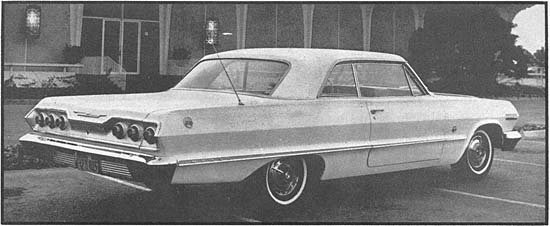 |
 |
| ONE OF THE automotive world's most interesting developments for 1963 is the wider application of huge, relatively slow-turning V-8 engines. Both Chevrolet (at 409 cu. in.) and Pontiac (421) have followed the trend set by Chrysler (413) a few years ago. Ford/Mercury (with 390), Dodge/Plymouth (383) and Oldsmobile (394) already had hydraulic lifter, single 4-barrel carburetored versions of earlier racing engines. |
| Chevrolet's high-torque model is a variation of its own successful 409-cu. in. racing engine (one won Stock Eliminator category in the NHRA championship drag races last summer) and follows the now-established pattern: hydraulic lifters, 4-barrel carburetor and a camshaft of more modest duration and overlap. Instead of developing the 425 bhp @ 6000 rpm of the racing engine, it produces 340 bhp @ 4600 rpm - a much more docile and livable amount. More important, the torque of this very large engine is no less than 420 lb.-ft. @ 3200 rpm, where the all-out engine produces only 425 lb.-ft. and that at 4200 rpm! | 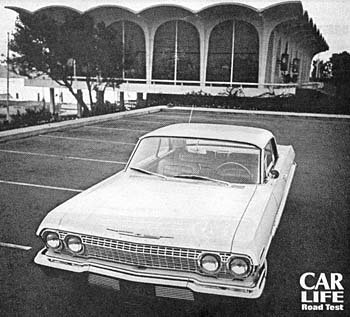 |
| This means that the engine in our test car develops more torque than the
425-bhp model over the speed range most used, i.e. from 500 to about 3500 rpm. Stated another way, the high torque 409/340 engine's advantage extends from 10 to 80 mph and at any speed in between it will have more high-gear punch than the 409/425 engine.
Do not, by the way, confuse this 340-bhp engine with the similarly rated engine option in the Corvette. All Corvette engines are the same size (327 cu. in.) and because of the (relatively) small displacement the 327/340 Corvette engine shows only 344 lb.-ft. @ 4000 rpm, 18% below the 409/340 engine. |
| With so much torque available it is quite surprising to find that the standard axle ratio is 3.36:1 (even the standard 230-cu. in. 6-cyl. models get a 3.08 axle ratio). However, the 409-powered models come with larger 8.00-14 tires as standard. At 60 mph this big 409 is still turning over at a modest 2600 rpm. Coupled to this powerhouse in Car Life's test '63 Impala SS is Chevrolet's traditional 2-speed Powerglide automatic transmission, the first of this combination offered to the general public. While the Powerglide has only one geared ratio (1st), the torque converter gives the benefit of an extra-low low and in effect there are 3 speeds forward, with an overall starting ratio of 12.4:1. | 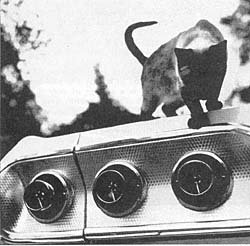 |
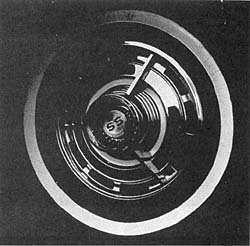 |
This, in our test car, was low enough to produce. any amount of wheelspin desired, even on dry pavement. As a matter of fact, there is so much torque that punching the throttle wide open at 40 mph will produce a very inspiring screech from the driving wheels and the car will literally leap ahead like the Impala for which it was named. However, it is easy to manage and wheelspin, too, is always controllable. Keep in mind one important proviso, however: it is not good judgment to put your foot down too hard when coming out of a corner, or when crossing a wet spot on the street. With so much acceleration available it is possible to pull out of a side street in front of oncoming traffic and punch it so hard the car will spin out! |
| Our usual data panel tells the acceleration story-a 0-60 time under 8 sec. isn't unusual these days but the real indication of performance is the 0-100 mph time. Last year (CL, Sept. '62) we tested one of the really hot Chevrolet 409 combinations, and with a 4-speed transmission. It romped to 100 corrected mph in 9.4 sec.! The Powerglide 409 isn't quite that much of a dragster but it is only 2 sec. slower to 60 mph and it gets to an indicated 100 mph on a very honest speedometer in just under 20 sec. As a further example of what might be called practical performance vs. the 409 Super Stocker, the elapsed time for the 1/4 -mile is only 3 sec. longer, with (again) Powerglide. The speed at the end of the 1/4-mile was exactly 90 mph, by the way. |
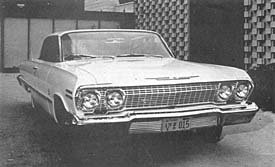 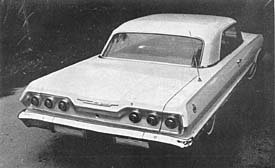
|
| So when the performance is there, what are the disadvantages? There are
a few of course, but nothing like those found in a typical car set up for drag racing and little else. This is a practical, docile, fun-to-drive car that is equally at home on the street or the expressway. The engine isn't quite as smooth and quiet as the 283 or 327 powerplants, but the difference is barely noticeable. Fuel consumption is a little heavier; we got an overall average of 12 mpg for 700 miles of assorted driving, which included taking occasional advantage of the tremendous performance. Here is a case where, even more than usual, the driver
is the key to economy. The extra urge is hard to resist and a lead foot would have to be satisfied with 10 mpg. On the other hand, a Mobilgas Economy Run type of driver could probably squeeze 16 mpg out of the car under ideal highway conditions.
Here we might go back to our earlier remarks regarding the surprising choice of axle ratio (3.36:1). This ratio was obviously chosen to give very high performance, rather than economy. In our earlier test of the new 6-cyl. engine (Car Life, November 1962) we remarked that "acceleration in the 40-60 mph range is decidedly weak." This would be expected from its performance factor of only 81.6 cu. ft. of explosion volume per ton-mile. The 409 V-8 factor is 150 cu. ft./ton mile, slightly higher than our December test car, a Sting Ray with 3.36 axle. Most buyers of the 409 would be well advised to specify the 3.08 axle, ratio. This is a change of only 8.3% and won't affect the performance by much, yet will improve gas mileage and, incidentally, raise the top speed to nearly 130 mph (the valve lifters pump up at just over 5600 rpm). As a matter of fact, it is unfortunate that Chevrolet's fastest axle ratio is 3.08. Pontiac, for example, offers ratios of 2.56, 2.69 and 2.87. Even the 390-cu. in. Cadillac has a standard axle ratio of only 2.94, giving a performance factor of 99.5 cu. ft./ton mile, which translates into very acceptable acceleration and hill-climbing ability. |
| POWER CURVES for the new 409/340 show a torque range of 4000 rpm at 360 lb.-ft. or more but a sharp gross horsepower peak. | 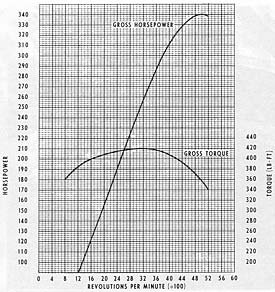 |